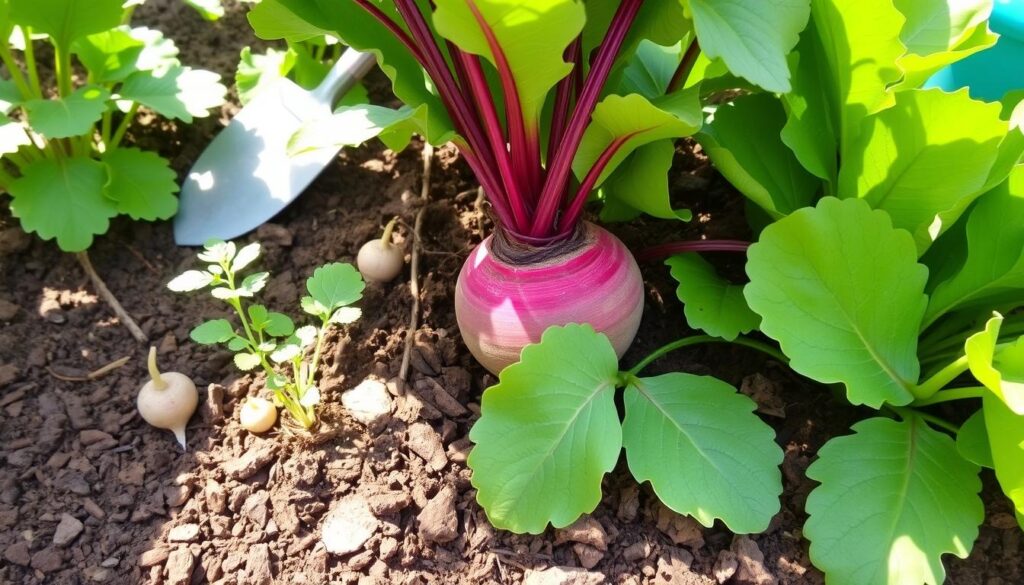Welcome to our guide on growing beets. Here, you’ll find tips to help you succeed. Growing beets can be rewarding, and with the right knowledge, you can enjoy a harvest of delicious beets.
Whether you’re a seasoned gardener or new to gardening, this guide has what you need. We’ll cover everything from choosing the right variety to harvesting your crop. You’ll get expert advice and helpful tips on growing beets.
In this guide, you’ll learn the basics of growing beets. You’ll discover how to grow beets that are full of flavor and nutrition. Plus, you’ll find out how to overcome common challenges that may arise.
Key Takeaways
- Learn the basics of how to grow beets and what to expect from the process
- Discover valuable beet growing tips to help you succeed
- Understand the importance of choosing the right variety of beets
- Learn how to prepare the soil for optimal beet growth
- Find out how to care for your beet plants and overcome common challenges
- Get expert advice on how to harvest your beets for maximum flavor and nutrition
Understanding Beet Basics
Before you start growing beets, it’s key to know the basics. Planting beets can be rewarding but needs some knowledge. A good beet care guide will help you grow beets successfully.
Types of Beets Available
There are many types of beets, each with its own traits and uses. Popular ones include Detroit Dark Red, Chioggia, and Golden Beets. Think about flavor, texture, and how long they take to grow when picking a type.
Beet Growing Seasons
Beets love cool weather and grow best in temperate climates. The best time to plant beets varies by location. Generally, plant them in early spring or late summer/early fall.
Basic Growing Requirements
To grow healthy beets, they need the right conditions. This includes soil that drains well, full sun to partial shade, and enough water. A beet care guide will give more details and tips for common issues.
Knowing these basics will help you grow tasty and healthy beets. Whether you’re experienced or new to gardening, a detailed beet care guide will guide you to success.
Choosing the Perfect Location for Your Beet Garden
When growing beets, the garden’s location is key for a good harvest. Beets need full sun and well-draining soil to grow well. Organic beet farming helps make a green and sustainable garden. The right spot ensures your beets get enough sunlight and water.
When picking a spot for your beet garden, consider these points:
- Full sun: Beets need at least 6 hours of direct sunlight per day.
- Well-draining soil: Beets don’t like wet feet, so make sure the soil drains well to prevent waterlogged soil.
- Soil quality: Beets prefer a slightly acidic to neutral soil pH, ranging from 6.0 to 7.0.
By thinking about these factors and using organic beet farming methods, you can grow a healthy beet garden. This garden will give you plenty of tasty beets for salads, soups, or pickling. The right spot makes all the difference.
With the right location and a bit of care, you can enjoy a successful beet harvest. You’ll get to enjoy the fruits of organic beet farming and harvesting beets yourself.
| Beet Variety | Sun Requirements | Soil Preferences |
|---|---|---|
| Detroit Dark Red | Full sun | Well-draining soil |
| Golden Beet | Full sun | Slightly acidic soil |
Soil Preparation and Requirements
Soil preparation is key for growing beets. The right soil can greatly impact your beet’s success. Whether indoors or outdoors, the soil must be fertile and drain well.
To get the soil right, test its pH level. Beets do best in slightly acidic to neutral soil, between 6.5 and 7.5. If your soil is off, add compost or well-rotted manure to fix it.
Ideal Soil pH Levels
The perfect pH for beets is 6.5 to 7.5. You can test your soil with a DIY kit or send it to a lab. Adjust the pH with lime to raise it or sulfur to lower it.
Soil Amendment Tips
To make your soil fertile and drain well, add compost, manure, or peat moss. These improve soil structure and hold water. For indoor beets, use a good potting mix.
Here are more tips for soil prep:
- Add a 2-inch layer of compost or manure to the soil.
- Mix in a balanced fertilizer as directed.
- Use a soil conditioner for better structure and drainage.
How to Grow Beets Successfully
Beet plant care is key for a good harvest. To grow beets, knowing the basics is important. Beets do best in cool weather and well-draining soil with a pH of 6.5 to 7.5.
To grow beets, start by mixing compost and fertilizer into the soil. This gives them the nutrients they need. Direct sowing is common, and it’s important to sow seeds at the right depth and spacing.
Direct Sowing Methods
For direct sowing, plant seeds 1-2 inches deep and 1-2 inches apart. Thin the seedlings to 3-4 inches apart as they grow. This lets the beets have enough room.
Spacing Requirements
Good spacing is vital for healthy growth. Beets can be grown in rows, with rows 12-18 inches apart. This ensures good air flow and prevents disease.
Watering Guidelines
Beets need consistent moisture, most during germination. Water the soil gently but thoroughly. Keep the soil moist for the first few weeks. As plants grow, water less, about 1 inch per week.
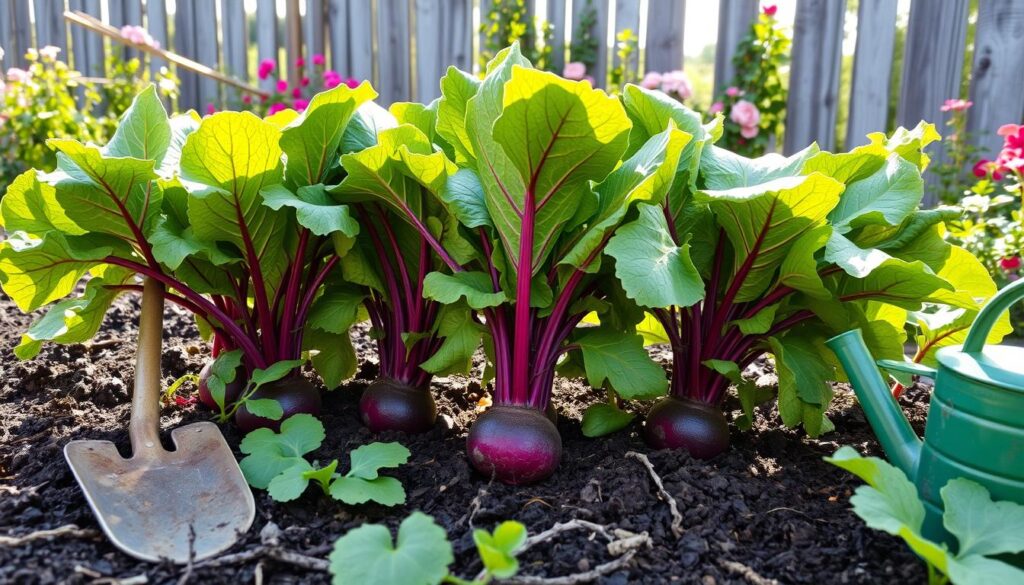
By following these tips, you’ll grow tasty and healthy beets. Remember to keep the soil moist, provide enough space, and use the right sowing methods for a great harvest.
Indoor Beet Growing Techniques
When it comes to beet growing tips, the location is key. Beets can grow indoors in containers or hydroponics. This method extends the growing season and ensures a steady supply of fresh beets.
For planting beets indoors, pick compact or dwarf varieties. They thrive in containers better. You’ll also need to ensure they get enough light and nutrients. Here’s how to start:
- Choose a container that’s at least 6-8 inches deep for root growth.
- Use a well-draining potting mix and fertilize regularly.
- Provide 12-14 hours of light daily, from a sunny window or grow lights.
By following these beet growing tips and using the right techniques, you can grow beets indoors successfully. Whether using containers or hydroponics, the goal is to create the right environment for your beets to flourish.
With practice and patience, you can master planting beets indoors. Enjoy the rewards of growing your own food at home.
| Beet Variety | Container Size | Light Requirements |
|---|---|---|
| Compact | 6-8 inches deep | 12-14 hours per day |
| Dwarf | 8-10 inches deep | 14-16 hours per day |
Essential Tools and Materials
Growing beets requires the right tools and materials for a successful harvest. A good beet care guide should list essential garden tools. These include a shovel, rake, and watering can. They help prepare the soil, plant seeds, and care for your beet garden.
Soil testing equipment is also key. It helps you check the soil’s pH level and nutrient content. This info ensures your soil is fertile for your beets. For more tips on setting up a garden, visit gardening websites.
Support systems like trellises and stakes are useful too. They keep your beet plants upright and organized. Here’s what you should include in your beet care guide:
- Garden tools: shovel, rake, watering can
- Soil testing equipment: pH tester, nutrient tester
- Support systems: trellises, stakes
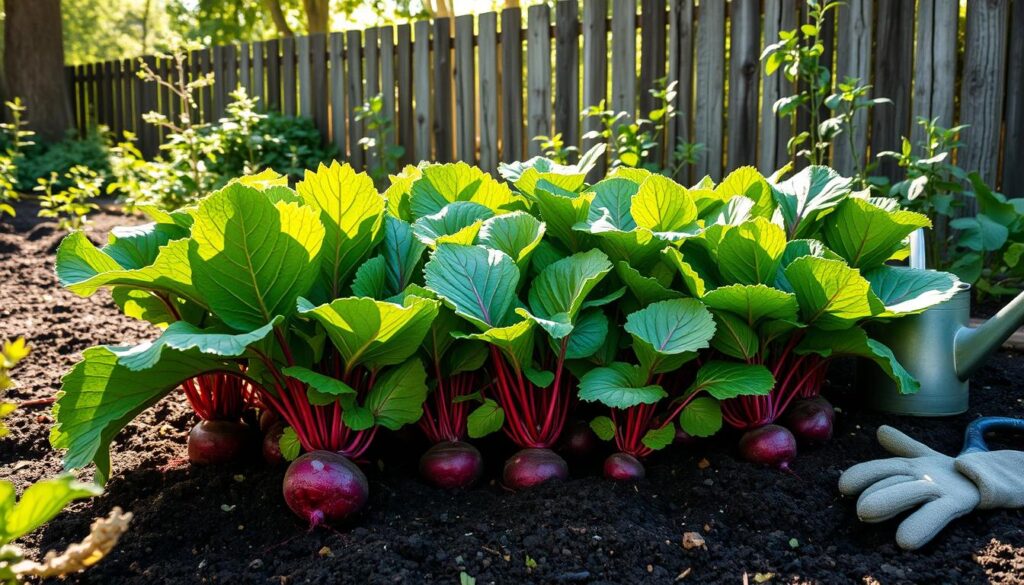
With the right tools and materials, growing healthy beets is easier. This makes harvesting beets a more enjoyable process.
Maintaining Healthy Beet Plants
For a successful organic beet farming experience, it’s key to keep beet plants healthy. This means picking the right beet varieties for your area and soil. With so many beet varieties out there, choosing the best one can be tough. But, by looking at maturity days, disease resistance, and taste, you can pick wisely.
Some top beet varieties are Detroit Dark Red, Chioggia, and Golden Beet. Each has its own special traits, fitting different organic beet farming settings. Knowing what your beet variety needs helps you care for it right, leading to better growth.
To keep your beet plants healthy and productive, they need the right conditions. This includes enough water, sunlight, and soil nutrients. By following these tips and picking the right beet varieties for your organic beet farming needs, you’ll get a great harvest. And you’ll keep your garden sustainable.
Natural Pest Control Methods
When growing beets indoors, keeping pests away is key. Beet plant care means knowing common pests and how to stop them.
Aphids, slugs, and snails are pests that harm beets. They can damage plants, lower yields, and spoil the beets’ quality.
Common Beet Pests
- Aphids: small, soft-bodied insects that feed on plant sap
- Slugs: slimy, nocturnal pests that feed on leaves and stems
- Snails: similar to slugs, but with a protective shell
Organic Solutions
There are organic ways to fight pests when growing beets indoors. Neem oil, diatomaceous earth, and insecticidal soap are good options. They’re safe for the environment and part of a good beet plant care plan.
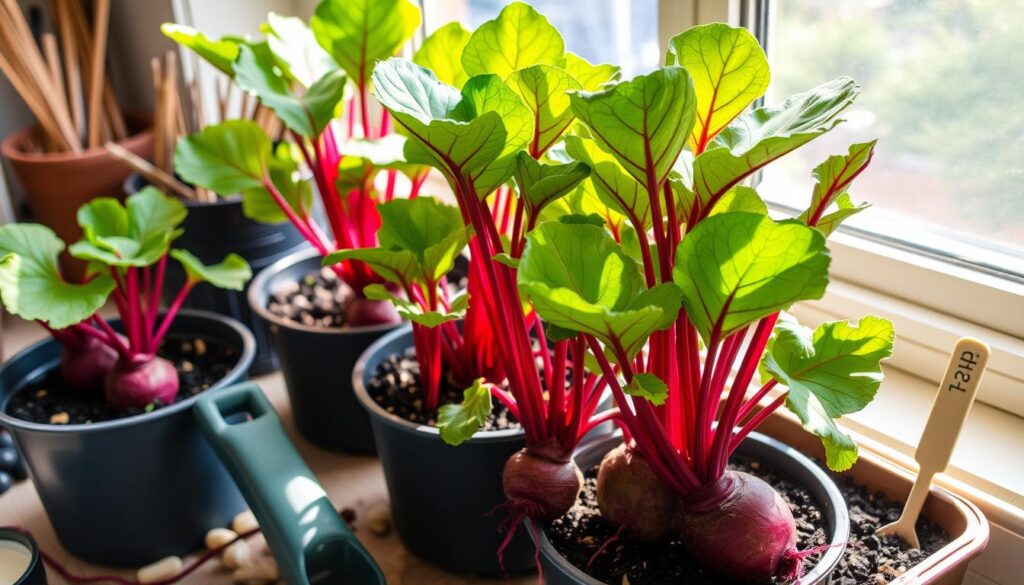
Preventive Measures
To keep pests away, use row covers, rotate crops, and stay clean. Check your plants often for pests. Act fast if you see any. These steps help you grow healthy, tasty beets.
| Pest | Organic Solution | Preventive Measure |
|---|---|---|
| Aphids | Neem oil | Row covers |
| Slugs | Diatomaceous earth | Crop rotation |
| Snails | Insecticidal soap | Good hygiene |
Disease Prevention and Treatment
When learning How to Grow Beets, disease prevention and treatment are key. Beet growing tips stress the need for a clean environment to avoid diseases. Common issues include powdery mildew and root rot, which can harm your beets.
To stop diseases, keep your garden clean, rotate crops, and use fungicides if needed. Organic fungicides are a good choice over chemical ones. Here are some helpful tips:
- Remove sick plants to stop disease spread
- Rotate crops to break disease cycles
- Keep tools and equipment clean
By following these tips and being proactive, you can keep your beets healthy. Always watch for disease signs and act fast to stop it from spreading.
Fertilizing Your Beet Crop
Planting beets requires a good fertilization plan for a great harvest. A detailed beet care guide shows that fertilizing is key for healthy growth. Giving your beets the right nutrients helps them grow strong and do well in many conditions.
First, knowing the different fertilizers is important. Organic choices like compost and manure are good for avoiding harsh chemicals. These natural options slowly release nutrients, feeding your beets as they grow.
Organic Fertilizer Options
- Compost: rich in nutrients and microorganisms, compost is an excellent way to improve soil health and fertility.
- Manure: high in nitrogen and phosphorus, manure is a great option for promoting healthy growth and development.
By following a good feeding schedule and using the right fertilizers, you’ll give your beets what they need. Watch for signs of nutrient lack, like yellow leaves or slow growth. Adjust your fertilizing plan as needed. With the right fertilizing, you’ll have a successful and plentiful harvest.
Companion Planting with Beets
Creating a well-planned garden is key for harvesting beets. Companion planting is a smart way to make your garden diverse and thriving. It’s great for organic beet farming. By growing certain vegetables, herbs, and flowers with your beets, you can boost their growth and flavor.
Onions, garlic, and lettuce are excellent companions for beets. They naturally keep pests away from your beets. Onions and garlic fight off aphids and other pests. Lettuce shades the soil and keeps it moist, helping your beets grow better.
Companion planting also improves soil health and adds biodiversity. Growing different crops together makes your garden more resilient. It’s a simple way to enhance your garden, whether you’re new to organic beet farming or experienced.
Other good plants to grow with beets include:
- Radishes
- Carrots
- Beans
- Cabbage
These plants help make your garden diverse and thriving. They can also help with harvesting beets by providing support. By using companion planting in your organic beet farming, you’ll get a more abundant and sustainable harvest.
Harvesting Your Beets
When your beets are ready, it’s important to know the right time to pick them. This ensures they taste great and are tender. Beets are usually ready in about 60 days, but this can change based on the type and where they’re grown.
To see if they’re ready, gently dig around the beet with a fork. Be careful not to hurt the roots. For most beets, the roots should be 1-3 inches thick. If you’re growing them indoors, check through the drainage holes.
Proper Harvesting Techniques
- Use a garden fork to carefully loosen the soil around the beet plant
- Lift the beets out of the ground, taking care not to damage the roots
- Trim the greens to about 1-2 inches from the crown to prevent moisture loss
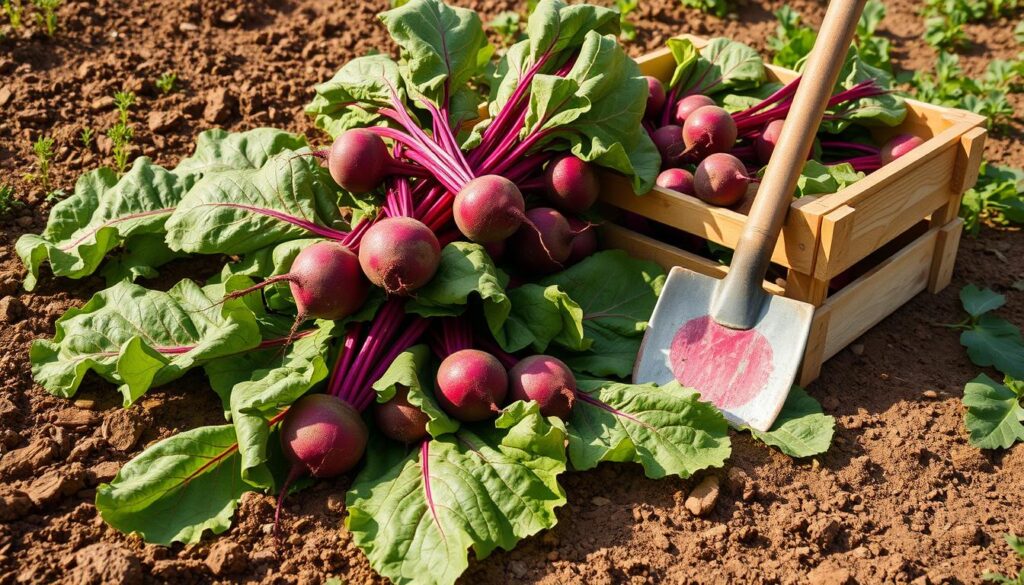
Storage Methods
To keep your beets fresh, store them in a cool, dark place. Make sure there’s good air flow. You can also store them in the fridge or freezer for longer. For longer storage, try pickling or canning them to enjoy all year.
| Storage Method | Shelf Life |
|---|---|
| Room temperature | 5-7 days |
| Refrigerator | 2-4 weeks |
| Freezer | 8-12 months |
Saving Beet Seeds
When it comes to beet plant care, saving seeds is key. It lets you keep your favorite variety and share it. First, let the seeds dry on the plant. Then, cut off the seed heads and dry them in a cool, dry spot.
To grow beets well, keeping seeds quality is important. Test seeds by placing a few in a damp paper towel. Wait for them to sprout. If most seeds grow, they’re good to plant.
- Store seeds in an airtight container to keep moisture in.
- Keep them in a cool, dark spot to prevent damage.
- Label the container with the variety and date for later identification.
By following these steps, you can save and share your favorite beet seeds. This way, you’ll have a great harvest for years.
| Seed Variety | Germination Rate | Storage Conditions |
|---|---|---|
| Detroit Dark Red | 80-90% | Cool, dry place |
| Golden Beet | 70-80% | Airtight container |
Conclusion
As we wrap up this guide on growing beets, it’s clear you can grow a great beet garden. You’ve learned about different beet types, how to prepare the soil, and manage pests. This guide has given you the tools to become a beet-growing pro.
For a good beet harvest, watch your plants closely. Make sure they get enough water, nutrients, and use natural pest control. By using the tips from this article, you’ll get fresh, tasty beets for many recipes.
Start your beet-growing adventure with excitement and a willingness to learn. This guide has given you the knowledge to grow beets that are good for you and make you happy. Happy gardening!
FAQ
What are the different types of beets available?
Beets come in many types, like Detroit Dark Red, Chioggia, and Golden Beets. Each type has its own look, taste, and growing needs.
When is the best time to plant beets?
Planting time for beets varies by location and weather. You can plant them in early spring or late summer for a fall crop.
What are the basic growing requirements for beets?
Beets need full sun and well-draining soil with a pH of 6.0 to 7.5. They also require consistent moisture and regular fertilizing.
How do I prepare the soil for growing beets?
First, test your soil’s pH and adjust it if needed. Add compost or aged manure to improve soil quality and fertility.
How do I sow beet seeds and space the plants?
Plant beet seeds 1 inch deep and 1-2 inches apart in the garden. Thin seedlings to 4-6 inches apart once they grow.
Can beets be grown indoors?
Yes, you can grow beets indoors in pots or with hydroponics. Choose a compact variety and ensure at least 6 hours of sunlight daily.
What tools and materials are needed for growing beets?
You’ll need a shovel, rake, watering can, and soil testing tools. Also, trellises or stakes might be needed for larger varieties.
How do I prevent and treat pests and diseases on my beet plants?
Common pests include aphids, slugs, and snails. Use neem oil, diatomaceous earth, or row covers to control them. For diseases, maintain good sanitation, rotate crops, and use organic fungicides if needed.
How do I properly fertilize my beet crop?
Use organic fertilizers like compost or well-rotted manure. Fertilize at planting and mid-season, following the recommended amounts. Watch for signs of nutrient deficiency.
What are some good companion plants for beets?
Beets pair well with onions, garlic, and lettuce. Companion planting can help deter pests, improve soil, and create a diverse garden.
When and how do I harvest my beets?
Beets are ready when the roots are 1-2 inches in diameter, about 45-60 days after planting. Gently dig around the plant and pull the beets. Store them in the fridge or freeze for later.
How do I save beet seeds for future planting?
Let the beets flower and produce seed heads. Collect them when they’re dry and brown. Store the seeds in a cool, dry place. Test the seeds before planting.
Share this post: on Twitter on Facebook

